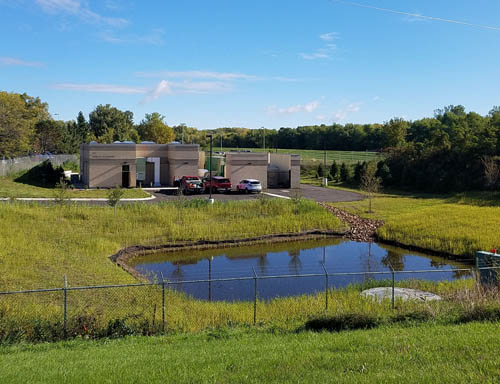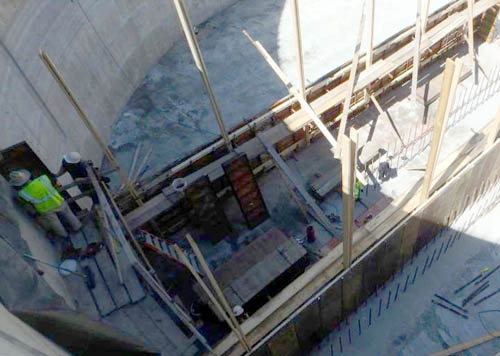Project blends in so well it stumped local residents
Over the last three years, Metropolitan Council Environmental Services (MCES) built a new, larger wastewater lift station that blended in so well with the surrounding community that its mission stumped even some local residents.
 Located on a two-acre site between the Carver County Government Center and the Minnesota River levee in Chaska, the structure goes deep underground, topped off with a couple above-ground buildings.
Located on a two-acre site between the Carver County Government Center and the Minnesota River levee in Chaska, the structure goes deep underground, topped off with a couple above-ground buildings.
The Chaska Herald took notice and published a photo of the new lift station in a weekly feature called, “Where the heck is it?” that asks readers if they can identify local landmarks.
“The following week, we provide the answer in a column we call, ‘Where the heck it was,” said editor Mark Olson.
Olson said only one reader correctly identified the new Chaska Lift Station.
Facilities designed to integrate into the community
MCES designed the station to look similar to other city and county buildings. According to Olson, “Lots of guessers thought it was the nearby government center or jail.”
 “That’s one of our goals,” said Jeannine Clancy, an assistant general manager at MCES, the region’s wastewater collection and treatment utility. “Regional wastewater infrastructure is primarily underground and intended to be out of sight, reliable, and therefore out of mind. But when we need to build facilities above ground, we try to ensure that they’re integrated into the community and nearby surroundings.
“That’s one of our goals,” said Jeannine Clancy, an assistant general manager at MCES, the region’s wastewater collection and treatment utility. “Regional wastewater infrastructure is primarily underground and intended to be out of sight, reliable, and therefore out of mind. But when we need to build facilities above ground, we try to ensure that they’re integrated into the community and nearby surroundings.
“Our Chaska Lift Station was very successful in meeting that goal,” said Clancy. “But even more important is its role in protecting public health and water quality and supporting the region’s ability to grow and prosper well into the future.”
New lift station serves growing southwest metro area
The Chaska Lift Station is part of a vast regional network of wastewater interceptor pipes, pump and metering stations, and treatment plants that MCES owns and operates in the seven-county area. It replaced a smaller and older lift station that didn’t have the capacity to serve the growing southwest metro area.
In fact, the previous lift station had replaced a small wastewater treatment plant in the 1990s, as MCES centralized its network of treatment plants.
The regional wastewater system treats about 250 million gallons of wastewater a day from 109 metro area communities and 2.6 million residents.
For its part, the Chaska Lift Station collects wastewater from local sanitary sewer systems in the cities of Carver and Chaska and pumps it to the MCES Blue Lake Wastewater Treatment Plant (PDF) in Shakopee. This plant serves 31 communities and approximately 300,000 residents. Once thoroughly treated, the water is returned to the environment via the Minnesota River.
“While not apparent from the outside, the lift station is about 40 feet underground and 74 feet across,” said Clancy. “It pumps as much as 13 million gallons of wastewater from Carver and Chaska each day.”
Lift stations help gravity do its job
The regional sanitary sewer system relies on gravity as much as possible to carry wastewater from metro communities through regional sewers to treatment plants. When wastewater flow hits low spots, however, lift stations are needed to pump it to higher elevations where gravity can once again take over.
Lift stations, like the one in Chaska, pump wastewater into forcemains, which are designed and built to handle wastewater moving under pressure. This series of gravity and forcemain sewers conveys wastewater to treatment plants, which remove pollutants and release the cleaned water back into the environment.
Improvements help preserve top-notch wastewater system
The $11 million Chaska Lift Station is part of a 10-year, $1 billion regionwide MCES initiative that began in 2013 to accelerate the work of updating and improving aging wastewater collection and treatment facilities.
To pay for investments in the regional system, MCES secures Minnesota Public Facilities Authority loans and/or issues bonds that are repaid with wastewater user fees that MCES collects from across the region.
MCES officials estimate the replacement value of the region’s investment in eight treatment plants, more than 600 miles of interceptor pipe and metering and lift stations to convey wastewater flow at $7 billion.
And that’s not including about 5,000 miles of sewers that local communities own and maintain.
More about MCES
Our region’s wastewater collection and treatment system is heralded as one of the best in the country, with charges to customers that are among the lowest compared with similar-sized systems.